|
The moving-coil speaker, which is capable of uncannily realistic reproduction, is now within the reach of many; amateurs. In this article Mr Harris deals with these instruments in his usual practical and very interesting manner.
It is over three years since I presented my credentials at the Research Laboratories of The General Electric Co., in Schenectady, for the purpose of examining the control room, transmitting apparatus, and the studios and research laboratories of WGY and 2XAF.
'I would like you to hear our new loud speaker', remarked my guide, pointing to a square box standing in one corner of a small studio. 'We think it is the best yet !'
Immediately adjacent to this room, and separated from it by a sound-proof glass partition, was a larger studio, photographs of which have appeared on many occasions in this and other journals. Taking me into the larger studio the studio manager sent for an accompanist, who forthwith sat down at a grand piano and played a rather intricate, and certainly very charming, tune, which had probably been chosen for its wide range of tone.
The First Experience
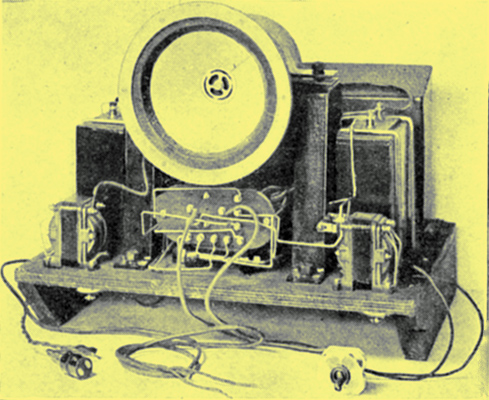
This is a front view of the Rice-Kellog loud speaker manufactured by BTH. The instrument includes a power amplifier and complete HT, LT and grid bias from the mains.
We returned to the first and smaller studio, and shut the door. Connections were made so that a condenser microphone in the main studio picked up the sound-waves and passed them to the station amplifiers. Instead of being put 'on the air', the signals were led to the Rice-Kellogg loud speaker and the strength adjusted so that the reproduction from the speaker was about equal to the original strength from the piano direct.
Weird and Uncanny
To say that I was startled would be greatly to underestimate the effect produced. It was weird and uncanny in its naturalness. Up to that time by far the best loud-speaker reproduction I had heard emanated from the Western Electric Kone loud speakers, used in conjunction with the Western Electric public address system in the Hotel Pennsylvania, New York. These cone loud speakers distributed the music through the hotel from a band playing in one of the dining-rooms. Hearing these had given me a shock, for their reproduction was greatly superior to anything I had heard up to that time in England. Nevertheless, I was totally unprepared for the big advance given by the Rice-Kellogg at WGY.
After the piano test one of the engineers went into the main studio and read about half a page of a magazine. Through the glass door I could see his lips moving, While his voice was coming from the Rice-Kellogg loud speaker.
Perfect Realism
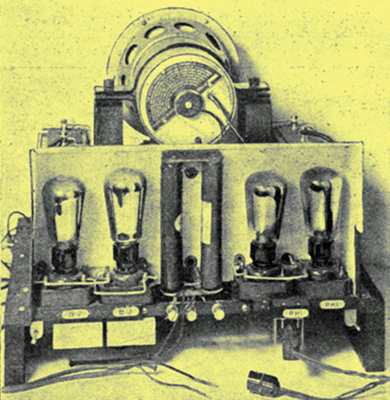
Another view of the BTH Rice-Kellogg instrument showing the power amplifier and rectifying valves.
'Listen carefully,' said the manager, 'and then come and listen to the same tune on the Rice-Kellogg loud speaker'.
It was difficult to realise that nothing, whatever was coming directly from him. A minute or two later he stopped, came through the door, and repeated the same passage in person. It was quite impossible to distinguish the difference.
In the afternoon I visited the various research laboratories which are distributed throughout large buildings. The policy of the General Electric Company is to engage a large number of brilliant scientists - mostly young men - and to equip them with everything they need for first-class research work, leaving them to work out their ideas without being worried every few minutes to see whether they have produced a commercial invention.
The Inventors
The idea is an expensive one, but I am sure it pays. Sometimes these men seem to work for a year or two without apparently producing anything of value, but at last comes some important invention which proves to be exceedingly profitable to the company.
In the late afternoon I was taken into the laboratory of Mr Rice and Mr Kellogg, who had worked together so successfully in evolving the new loud speaker. Around the laboratory were specimens of almost every known loud speaker, and switches by which they could be rapidly compared. There was also an audio-frequency oscillator capable of giving a pure note which could be varied from the lowest to the highest in the audible range.
I learned a great deal about loud speakers that afternoon, and many of my illusions were shattered. I realised. for the first time how hopelessly inadequate was the reproduction of the low notes by the then existing loud speakers, and how those which seemed to reproduce the lower tones gave them very unfaithfully.
I also realised how the repression or accentuation of the harmonics of a note can completely alter its character. One experiment which Mr Kellogg showed me brought this out very clearly.
An Interesting Test
Suspended from a piece of board were a number of very large glass bottles, the mouths of the bottles projecting through the board. Water at various depths had been poured in these bottles, and a kind of Xylophone rod placed over each so that when the rods were struck one obtained a musical note which resonated in the bottle, giving rather a pleasing and rich musical effect, this being largely due to the number of harmonics of the fundamental note.
Mr Kellogg then played a few simple tunes on the scale so that I could accustom my ear to the true reproduction, and then went into another room and played the same little tunes before a microphone so that the output could be fed into any of the loud speakers in the laboratory where I was listening. I now had another shock in fact, I was becoming accustomed to shocks on that memorable day - for the sound which emerged from the various loud speakers did not in a single instance even remotely resemble the tones I had heard directly from the instrument.
Other Types Fail
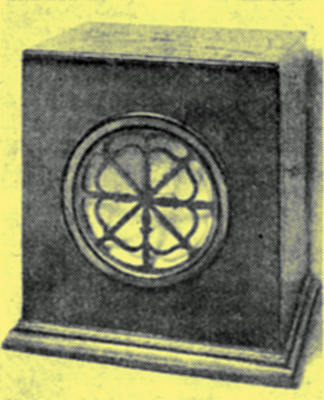
The 'Cameo' moving coil speaker cabinet which gives an effect equivalent to a large baffle.
In many cases the change from one loud speaker to another produced an entirely different set of sounds, only recognisable as coming from the same source by the continuation of the air. Mr Rice now switched the output of the microphone over to the Rice-Kellogg speaker, and immediately the reproduction was faithful to the original.
I was then shown how important was the influence of the baffle board, for without this board reproduction was thin and poor, and not greatly superior to that given by the best of the other loud speakers. While the tune was being played the baffle board was gradually brought closer and closer to the cone, and as soon as it became within an inch of it low tones began to be produced which had been inaudible before.
All this happened three years ago, and I suppose I was one of the very first if not actually the first Englishman to hear this now famous loud speaker. I described it on my return, and within the last twelve months, a large number of moving-coil speakers based on the same general principles have been produced. and kits placed on sale, so that this high-quality reproduction is becoming more and more available to the man-in-the-street.
Now On Sale
The official Rice-Kellogg loud speaker has been on sale in England for some time by the British Thomson-Houston Company, but its price or, rather, the price of the outfit as sold - placed it beyond the reach of the ordinary man until a few weeks ago. I have heard many grumble at the high price charged by the BTH Co. for this loud speaker, but it should be remembered that it included not only the loud speaker, but a high-grade amplifier, together with means of obtaining from the mains not only the large value of high-tension current necessary, but also the low tension current for lighting the filaments of the amplifier valves. The complete outfit contains a transformer, two rectifying valves, means of obtaining a large value of grid bias, two amplifying valves, input and output transformers, a complete smoothing system with chokes and condensers, a large electro-magnet energised by a current obtained from the rectifying and smoothing device, and the speaker itself. Such a complete outfit, when attached to an ordinary receiver capable of giving medium loud-speaker strength, will immediately give a most wonderfully natural reproduction at a strength greater than is necessary for an ordinary living-room. It can, of course, be toned down to what one requires.
The Wireless Constructor, knowing the real facts of the case, has been careful not to mislead its readers into thinking that a moving-coil speaker without adequate amplifying devices will give satisfactory reproduction on an ordinary set. A moving-coil speaker without the amplifier can now be obtained at a reasonable price, the BTH and Magnavox moving-coil speakers selling without their special amplifying equipment at about £9 10s, while the home constructor can build it for himself from kits of parts sold by many manufacturers a really excellent instrument at a much lower cost than this.
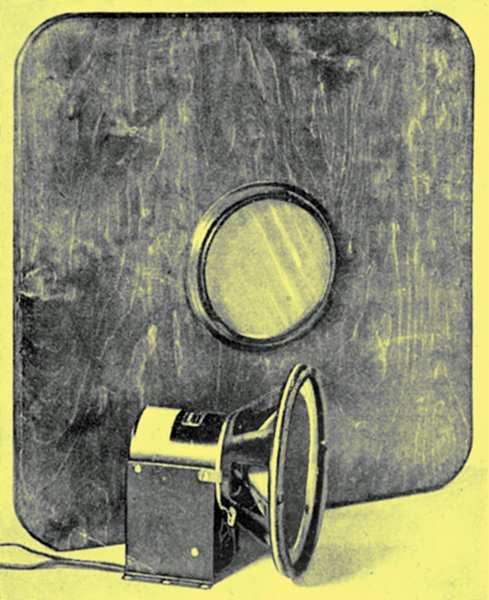
A Magnavox unit together with a suitable baffle board. A baffle board is essential if the speaker is to operate with realism and efficiently project low notes.
Average Conditions
Granted, however, that the reader has obtained a moving-coil speaker - either one of the makes named, or made up from a kit - what kind of results is he going to obtain if he connects it to, say, an ordinary set consisting of a detector and a, couple of note magnifying valves? If he has a, good moving-coil speaker, he will obtain results which in strength are generally inferior to those given by the horn or cone types, and in quality will be a little superior to those given by the ordinary types of cone. If he has not heard a good modern cone, he will perhaps be delighted; but if he is acquainted with the ordinary types of good speaker, he will probably wonder whether the trouble he has taken is worth while.
It is not generally realised that the lower one descends in the musical scale, the greater amount of power is required to reproduce good notes on the loud speaker. No loud speaker can give a better reproduction than the set itself is capable of giving, and it can be taken as definite that an ordinary receiver, even with a super-power valve in its output, using 120 or 150 Volts on the anode and proper grid bias, cannot properly reproduce the low notes which are in the transmission (and which a good moving-coil speaker is capable of reproducing) without reaching the blasting point.
Milliammeter Test
To give proper reproduction, free from distortion, the milliammeter in the plate circuit of the output valve should he perfectly steady all the time. You may imagine you are not getting distortion on your present outfit, but once you have heard proper, undistorted reproduction, you will never have any further illusions on the subject.
Because the ordinary set, using ordinary output arrangements, will not do justice to a good modern moving-coil speaker, many people who have obtained such speakers, or built them up from kits, have been greatly disappointed.
Avoid Overloading
How, then, can we get that natural reproduction which should be our reward for the work we do? Simply by seeing first of all that our loud speaker gives faithful reproduction by using high-grade transformers and/or resistance coupling, and, secondly, by seeing that our output valve or valves can handle the undistorted energy necessary for the proper reproduction.
With a single output valve, about 350 Volts on the anode of such a valve as the LS5A, and something in the neighbourhood of 80 to 100 Volts grid bias, is used by many experimenters who are only just getting what they want. High voltages are rather dangerous in unskilled hands, and, personally, after many experiments, I have found that for ordinary use a push-pull outfit with 150 Volts on the anode of a pair of super-power valves will really do justice to a good modern moving-coil speaker and give delightfully natural reproduction.
A Suitable Amplifier
A suitable amplifier has already been described in these pages (Super Quality with any Set, March, 1928, issue), and for those readers who already have a set which they know gives good quality, but not quite sufficient output, the push-pull amplifier described in the last issue will give excellent results.
Better results are obtained with an electro-magnetic field, but, of course, this takes extra current, which is a disadvantage to the man who has to get his accumulators charged and who is not on the mains. There are two kinds of excited field windings sold, one taking a fairly large current (half to one ampere) from a 6 Volt accumulator and the other taking a small current at a much higher voltage either from a rectifier in the case of AC mains or direct from the DC mains, when these are available.
Good Speakers
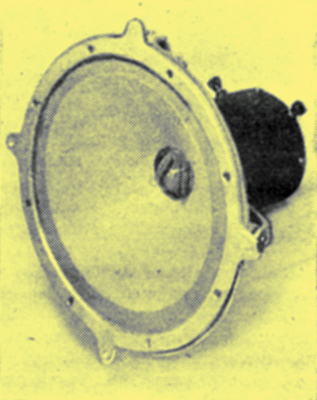
The 'Sylphone' moving-coil speaker unit which possesses several novel features.
The strength of magnetic field produced in either form of electromagnet is approximately the same, although the stronger the field the better. Personally, in the excited field type, I generally use the low-voltage, winding, running it from, a trickle charger, such as the Ferranti,' or from one of my 'Stedipower' LT Units. It can, of course, be run quite successfully from ordinary 6 Volt accumulators, but when we consider that a moving-coil speaker with a 6 Volt winding requires as much current for exciting its magnet as do the filaments of a five-valve set, we see that the permanent-magnet type is bound to appeal to residents who are not conveniently placed for charging.
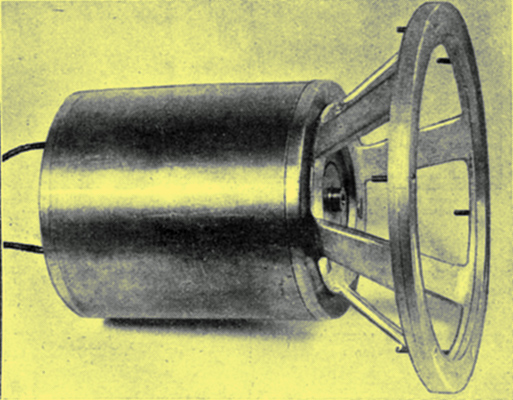
This is the field 'pot' and frame of a moving-coil speaker unit. The moving coil and diaphragm have been removed.
One illustration shows the excited field winding or 'pot' obtainable for the Cromwell Engineering Companybs speaker already described in these pages in its permanent-magnet form. Those readers who have the current available and who would like to change over from the permanent magnet to the excited field can obtain the necessary parts on application to the makers.
The Squire loud speaker also illustrated, and made up from their 'kit', is a particularly good specimen of an excited field type having several original features. Personally, I place it in the very front rank. Another excellent 'kit' speaker which has been greatly improved since it was first placed on the market is the Goodman.
The Goodman is distinguished by a number of very ingenious mechanical devices and the method adopted by the makers for centering is particularly ingenious. The actual moving coil is supplied already wound and the work of making up the cone and its suspension is well within the capabilities of any ordinary experimenter.
The BTH Co. are now selling a Rice-Kellogg speaker completely made up for use, but without amplifier, designed to run from a 6 Volt accumulator. This speaker is identical with that used in the complete outfit already described. The Magnavox Company, who have a great experience in manufacturing moving-coil speakers, sell a 6 Volt unit, as illustrated, both with and without the amplifier. A complete Magnavox with amplifier can be obtained to run directly from the mains, the mains supplying not only the filament current for the amplifier, but also the plate current grid bias and the exciting current for the field windings.
In addition to those speakers and kits named in the present article there are a number of others of excellent quality now available. The points which I would particularly like to emphasise are, firstly, that no moving-coil speaker can give a better reproduction than the set is capable of rendering, and, secondly, it is essential that the output of the wireless receiver should be undistorted and of adequate power.
Pure Output Essential
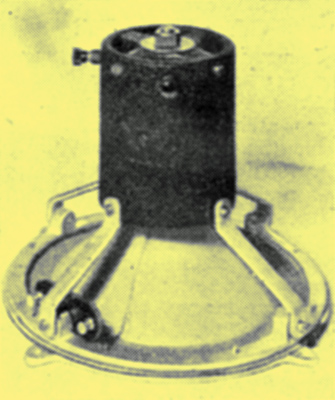
Another view of the 'Sylphone' speaker showing the ventilation provided at the back of the instrument for cooling the 'pot'.
Moving-coil speakers as a whole are not so sensitive as the best modern cones, so that quite apart from obtaining undistorted reproduction we must have adequate volume to work them. Thirdly, remember that the strength of the chain is in its weakest link, and that if in your receiver you have a poor resistance amplifying unit or a poor transformer the effects of these cannot possibly be corrected by the best push-pull amplifier.
To the man who wants the best quality reproduction now possible, I would say most emphatically, obtain a good moving-coil speaker, but if you are not prepared to supply adequate high-tension from HT accumulators or a mains unit and are not prepared to go in for push-pull, parallel running of output valves, or a high voltage on a single output valve, then it is better to obtain one of the good modern cone loud speakers and to give up the idea of the moving-coil speaker for the time being.
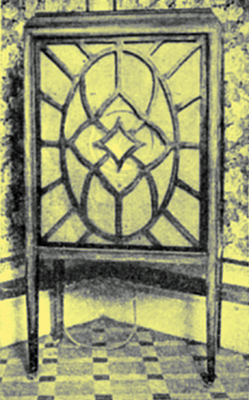 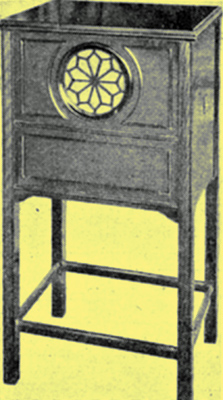
|